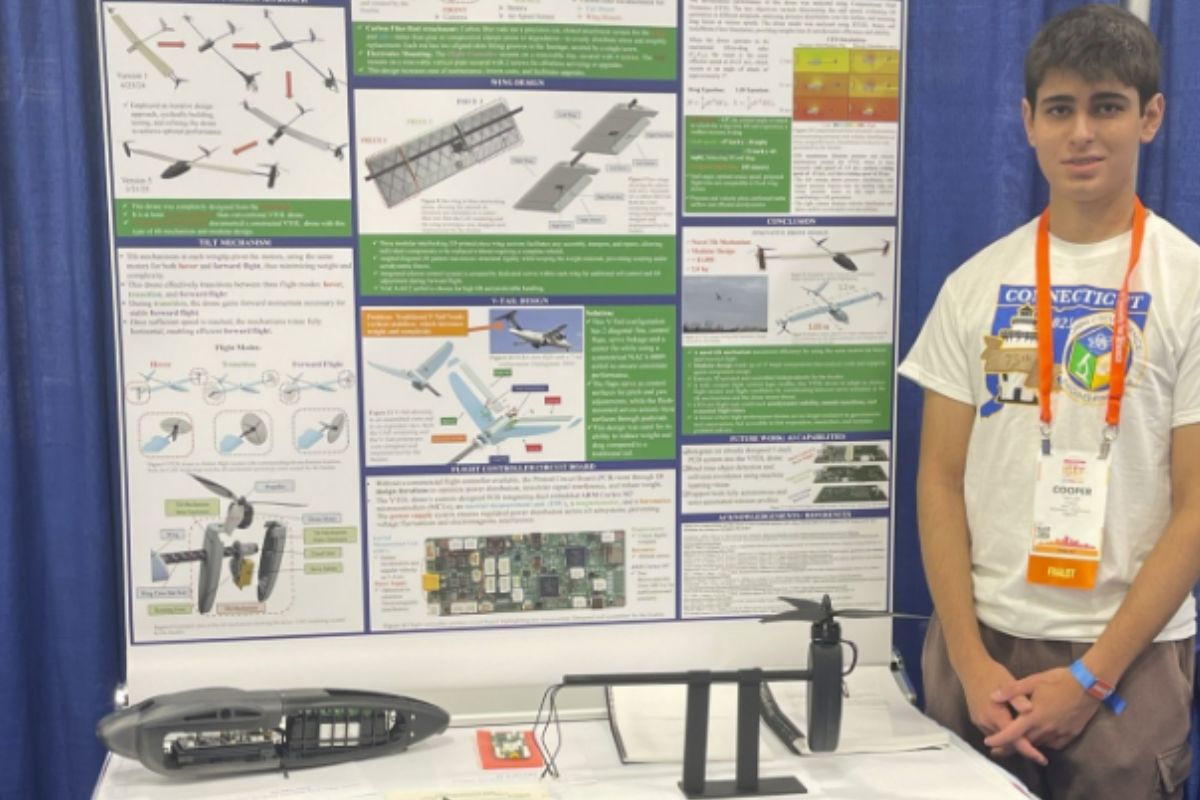Show table of content Hide table of content
In a suburban garage, a 17-year-old American prodigy has engineered what experts are calling a game-changing drone innovation. This teenage genius developed a vertical takeoff and landing (VTOL) drone that operates more efficiently than commercial models while costing significantly less. His groundbreaking creation has captured the attention of the Pentagon, resulting in $23,000 in awards from the Department of Defense.
Young inventor revolutionizes drone technology with 3D printing
The journey began with a simple observation. When Taylor’s younger sister received a consumer drone that delivered only 30 minutes of flight time, the tech-savvy teenager saw room for improvement. Instead of accepting existing limitations, he immersed himself in VTOL mechanics – aircraft capable of helicopter-like takeoffs followed by airplane-style forward flight.
What Taylor discovered was an industry bottleneck: current VTOL drones were prohibitively expensive and remarkably inefficient. Most models incorporated multiple motors, with several remaining inactive during certain flight phases, wasting both energy and resources.
His solution? A system of tiltable motors that handle both vertical liftoff and horizontal propulsion. The ingenuity lies in his manufacturing approach – creating the entire structure using 3D printing techniques with modular components.
“The inefficiency in current designs seemed obvious once I started researching,” Taylor explained. “Why carry dead weight when you could have motors serving dual purposes?”
This approach allows users to customize their drones by swapping wings, tails, or adding sensors based on specific mission requirements. In an era where technological breakthroughs are redefining how we interact with devices, Taylor’s innovation represents a significant step forward in accessible aerospace engineering.
From basement workshop to military recognition
The development process demonstrated remarkable self-sufficiency. Taylor personally handled every aspect of creation – from 3D printing and soldering to coding the onboard software and designing electronic circuits. He devoted an entire summer to refining prototypes in his basement, acquiring knowledge through online forums and courses.
Science This strange red lake in Tanzania turns animals to ‘stone’.
Initial tests proved challenging. The first three prototypes crashed, resulting in hundreds of dollars in losses. However, each failure provided valuable lessons that informed subsequent iterations. The fourth prototype successfully completed its flight and landing sequence, validating his innovative approach.
Industry analysts note how unusual it is for the Department of Defense to show interest in technology developed by someone so young. The military’s attention highlights the potential strategic applications of affordable, modular VTOL technology in reconnaissance and logistics operations.
Taylor’s approach to problem-solving mirrors patterns seen in other technological fields where artificial intelligence and automation are driving rapid transformations. His ability to iterate quickly through failures demonstrates the kind of resilience typically found in seasoned engineers.
The recognition from military authorities comes at a time when defense departments worldwide are seeking cost-effective solutions to maintain technological advantages without the massive budgets of previous decades.
Democratizing advanced flight technology
Beyond its technical merits, Taylor’s drone represents a democratization of advanced flight technology. By reducing costs to approximately one-fifth of market alternatives while enhancing customization options, he’s made professional-grade capabilities accessible to users who previously couldn’t afford them.
Applications extend far beyond military use. The affordable VTOL platform opens possibilities in agricultural monitoring, emergency response, medical deliveries to remote areas, and wildlife conservation. Environmental scientists have expressed particular interest in how such technology could help monitor ecosystems affected by climate change – a growing concern since Stephen Hawking’s dire warnings about Earth’s future.
The drone’s modularity addresses another critical issue in technology deployment: adaptability to varying conditions and requirements. Users can configure a single platform for multiple missions rather than purchasing specialized equipment for each task.
“What’s remarkable about this invention isn’t just its technical sophistication, but how it democratizes access to advanced aerial capabilities,” noted Dr. Elena Serrano, aerospace engineering professor at Stanford University. “This could significantly expand drone applications in developing regions.”
Science 50 years later, a quantum mystery has finally been solved.
This potential for global impact is particularly significant given recent revelations about population distribution and resource allocation challenges facing humanity. Affordable drone technology could help bridge infrastructure gaps in regions with limited access to traditional transportation networks.
The future takes flight
While many teenagers devote their free time to social media or gaming, Taylor continues refining his invention. He’s currently developing a seventh-generation prototype designed for even greater portability – compact enough to fit inside a backpack.
This summer marks another milestone in his journey as he joins MIT’s Reliable Autonomous Systems Laboratory to further his research. The prestigious appointment demonstrates how his self-taught expertise has earned recognition from leading academic institutions.
Industry experts predict Taylor’s innovations could catalyze broader changes in drone manufacturing, potentially shifting the industry toward more modular, user-serviceable designs. His open-source approach to certain aspects of the technology encourages collaborative improvement.
Science These people were paid not to use Google, yet they couldn’t resist.
The significance of this teenage inventor’s accomplishments extends beyond the specific technology he’s created. It represents how individual ingenuity, combined with accessible manufacturing tools like 3D printing, can disrupt established industries previously dominated by large corporations with extensive resources.
As autonomous flight technology continues evolving, Taylor’s contributions may be remembered as a pivotal moment when advanced aerospace capabilities became accessible to ordinary users – all because a determined teenager wasn’t satisfied with his sister’s drone performance.


